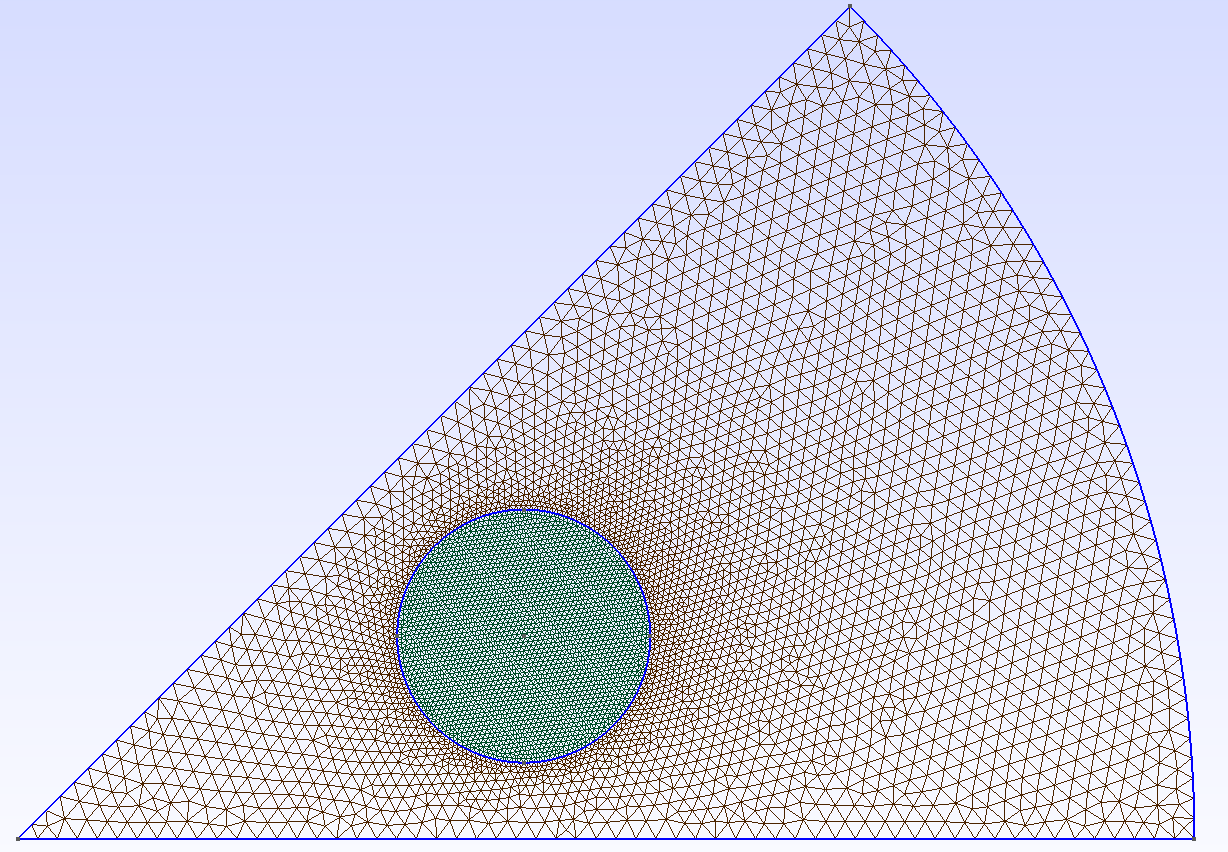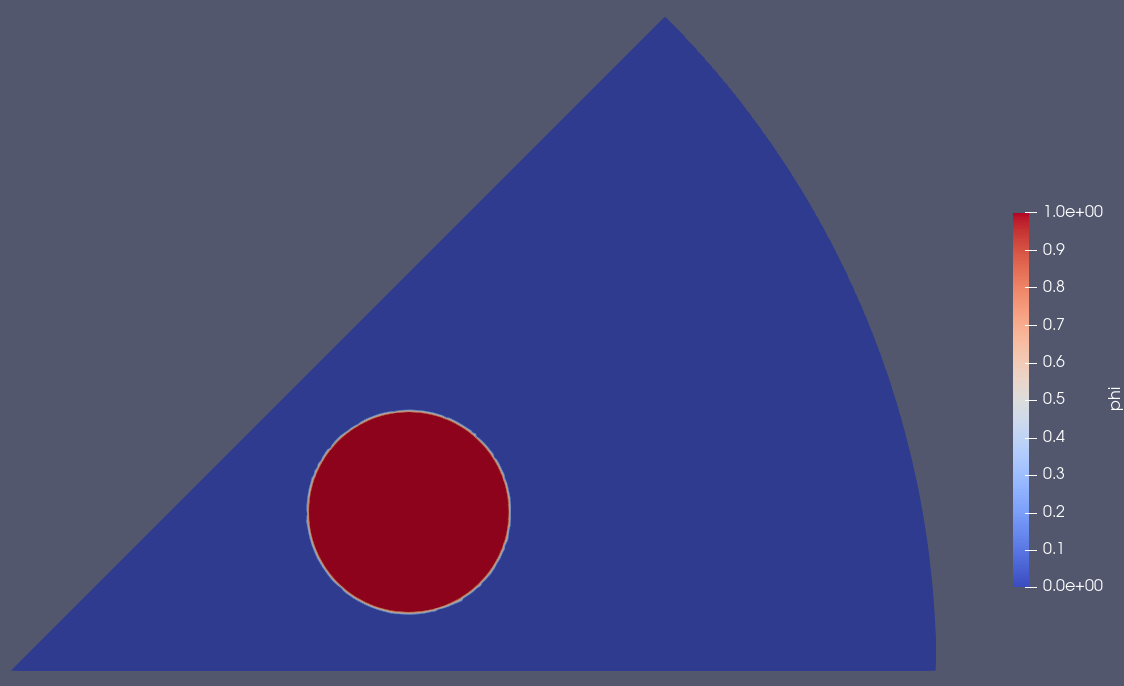Variables¶
This page described how to define and manage variables in SLOTH.
Definition of variables for SLOTH is made with a C++ object of type Variables that is simply a set of C++ object of type Variable.
As for the object SpatialDiscretization (see Meshing), Variable is a template class instantiated with two template parameters: first, the kind of finite element, and second, the spatial dimension.
The kind of finite element refers to a C++ class that inherits from the mfem::FiniteElementCollection. This class manages all collections of finite elements provided by MFEM.
Currently, the most commonly used finite element collection in SLOTH is mfem::H1_FECollection, which corresponds to arbitrary order H1-conforming continuous finite elements.
The dimension is simply an integer that can be 1, 2, or 3.
Alias declaration for Variable class template
Variable class template instantiated with mfem::H1_FECollection in dimension 3.This alias is often used in tests in order to simplify the code.
Variable description¶
SLOTH differentiates between primary variables, that are solved directly by the problem (eg. the order parameter for the Allen-Cahn equation, the order parameter and the chemical potential for the Cahn-Hilliard equation), and secondary (or auxiliary) variables, which are derived from another problem to ensure multiphysics coupling (eg. the order parameter in the heat transfer equation, the temperature in the Allen-Cahn equation).
Both kind of variables are defined in the same way.
Mandatory parameters¶
The Variable object must be defined by:
- the spatial discretisation (see Meshing),
- a set of boundary conditions (see BoundaryConditions),
- a name (C++ type
std::string), - a type (
SLOTHtypeGlossaryQuantity), - a storage depth level (C++ type
int), - an initial condition.
The initial condition can be defined by a constant, a C++ object of type std::function or a SLOTH object of type AnalyticalFunctions.
The latter enables to use pre-defined mathematical functions currently used in the studies conducted with SLOTH. If the mathematical expression is not yet available, the users can define it with a C++ object of type std::function.
Example of Variableobjects with mandatory parameters
The following examples assume that the spatial discretisation and the boundary conditions are defined.
In the code snippets, the first is referred to as a spatial object, while the second is referred to as a bcs object. Without loss of generality, the alias VAR is also used.
These examples show how to initialize a variable with double, AnalyticalFunctions and std::function types.
In this example, the variable is named phi. Its initial value is zero.
In this example, the variable is named T. It is defined by a parabolic profile.
int level_of_storage= 2;
std::string variable_name = "T";
GlossaryQuantity variable_type = Glossary::T;
auto initial_condition = std::function<double(const mfem::Vector&, double)>(
[](const mfem::Vector& vcoord, double time) {
const double Text = 800.;
const double radius = 4.e-3;
const double puissance = 20.e4;
const double conductivity = 2.;
const double r2 = radius * radius;
double rr = std::transform_reduce(vcoord.begin(), vcoord.begin() + std::min(vcoord.Size(), 2), 0.0, std::plus<>(), [](double x) { return x * x; });
const auto func = Text + puissance * (r2 - rr) / (4. * M_PI * 2. * r2);
return func;
});
auto var_1 = VAR(&spatial, bcs, variable_name, variable_type, level_of_storage, initial_condition);
In this example, the variable is named phi. It is defined by a 2D hyperbolic tangent profile.
int level_of_storage= 2;
std::string variable_name = "phi";
GlossaryQuantity variable_type = Glossary::Phi;
const double center_x = 0.;
const double a_x = 1.;
const double thickness = 5.e-5;
const double radius = 5.e-4;
auto initial_condition = AnalyticalFunctions<2>(AnalyticalFunctionsType::HyperbolicTangent, center_x, a_x, thickness, radius)
auto var_1 = VAR(&spatial, bcs, variable_name, variable_type, level_of_storage, initial_condition);
SLOTH provides several pre-implemented analytical functions, including the Heaviside function, sinusoidal profiles, hyperbolic tangent, and parabolic profiles. Each of these functions requires a set of parameters detailed in a dedicated page of the user manual.
Optional parameters¶
In addition to the mandatory parameters, definition of Variable can be enhanced by an analytical solution with the same type as the initial condition.
Definition of variables with an analytical solution
The presence of an analytical solution automatically enables the calculation of the error over the domain.
The initial condition can also be asscoiated with a set of attributes names that correspond to PhysicalNames defined in the GMSH file mesh.
In this case, the list of attributes (ie the PhysicalNames defined in the GMSH file mesh) must be defined in a C++ container of type std::set<std::string>, just after the initial condition.
Example of initialization based on PhysicalNames of a GMSH file mesh
Please find the following extract of a GMSH file mesh used to build an inclusion inside a fragment of material:

In the following example, the variable named phi is equal to one within the inclusion associated with the attribute 'cluster' and zero elsewhere.
int level_of_storage= 2;
std::string variable_name = "phi";
GlossaryQuantity variable_type = Glossary::Phi;
double initial_condition = 1.;
std::set<std::string> list_of_physical_names = {"cluster"};
auto var_1 = VAR(&spatial, bcs, variable_name, variable_type, level_of_storage, initial_condition, list_of_physical_names);

Additional information¶
Processing certain physical problems requires additional information to distinguish variables.
This information is provided in the form of a list of strings associated with the variables using the public C++ method set_additional_information.
Example of variables definition with additional information
The following example refers to Calphad problems (see Problems for more details).
The first variable, named Ma, corresponds to a mobility coefficient whereas the second one is associated with a chemical potential named mu_a.
For a Calphad problem, managing the variables requires knowing the type of each variable. By convention, the last additional information corresponds to a pre-defined symbol (e.g., 'mu' for chemical potentials and 'mob' for mobilities).
The definition of chemical potentials requires the name of the chemical element, whereas for mobilities, both the name of the phase and the name of the chemical element must be specified.
int level_of_storage= 2;
std::string variable_name_1 = "Ma";
GlossaryQuantity variable_type = Glossary::Mob;
double initial_condition_1 = 1.e-15;
auto var_1 = VAR(&spatial, bcs, variable_name_1, variable_type, level_of_storage, initial_condition_1);
var_1.set_additional_information("SOLUTION", "A", "mob");
std::string variable_name_2 = "mu_a";
double initial_condition_2 = 1.e5;
auto var_2 = VAR(&spatial, bcs, variable_name_2, variable_type, level_of_storage, initial_condition_2);
var_2.set_additional_information("A", "mu");
Conventions used to associate additional information with variables for each kind of SLOTH problem are detailed in Section Problemsof the user manual.
Variables¶
The C++ class Variables allows to define a collection of Variable objects.
As for the object Variable, Variables is a template class instantiated with two template parameters: first, the kind of finite element, and second, the spatial dimension.
Each SLOTH problem (see Problems for more details) requires a Variables object as input argument.
Example of Variables definition
std::string variable_name_1 = "mu_a";
GlossaryQuantity variable_type = Glossary::Mu;
double initial_condition_1 = 1.e5;
auto var_1 = VAR(&spatial, bcs, variable_name_1, variable_type, level_of_storage, initial_condition_1);
var_1.set_additional_information("A", "mu");
std::string variable_name_2 = "mu_a";
double initial_condition_2 = 2.e5;
auto var_2 = VAR(&spatial, bcs, variable_name_2, variable_type, level_of_storage, initial_condition_2);
var_2.set_additional_information("A", "mu");
auto mu_var = VARS(var_1, var_2);
This example shows the definition of two variables that correspond to chemical potentials. These variables are gathered within a Variables object that can be used as primary variables for a CALPHAD problem and as auxiliary variables for ThermalDiffusion problems.